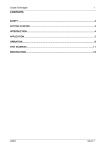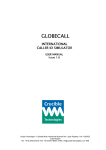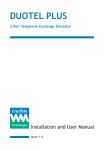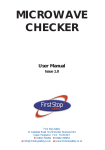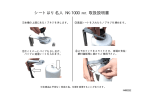Download PAT-IT - First Stop Safety
Transcript
FIRST STOP SAFETY PAT-IT Portable Appliance Tester User Manual Issue 1.6 First Stop Safety 11 Glaisdale Road Northminster Business Park Upper Poppleton York YO26 6QT t: 01904 791050 f: 01904 780054 e: [email protected] w: www.firststopsafety.co.uk PAT-IT ISSUE 1.6 FIRST STOP SAFETY PAT-IT ISSUE 1.6 FIRST STOP SAFETY FIRST STOP SAFETY 1 Contents SAFETY 2 GETTING STARTED 3 INTRODUCTION 4 FEATURES 5 PLANNING THE TESTS Determining the Class of construction Type of equipment Type of environment Frequency of visual inspection and testing Equipment Register 6 6 7 7 8 9 OPERATION Formal Visual Inspection Testing Class I equipment Testing Class II equipment Testing IEC leads Testing mains extension leads Testing 110 V appliances Testing 3-phase appliances 10 10 12 13 13 14 14 14 SPECIFICATION 15 APPENDIX I - Wiring of Mains Plug APPENDIX II - Examples of Visual Inspection failures APPENDIX III - Suggested Frequency of Inspection & Testing of Equipment 16 17 Additional notes on PAT-IT use 20 18 PAT-IT PAT-IT ISSUE 1.6 ISSUE 1.6 FIRST STOP SAFETY FIRST STOP SAFETY 2 SAFETY Please read this manual carefully to make yourself familiar with the capabilities and functions of the PAT-IT before attempting to use it. The PAT-IT uses high voltages for some measurements and it is important that due care is taken during its use. 1. The PAT-IT is designed to be used by suitably trained personnel. However, this manual contains all the information necessary to carry out in-service testing of all electrical appliances. Therefore reading thismanual, will provide adequate information to be able to carry out these tests. If after reading this manual you are still not confident about carrying out the tests then please consider either - attending one of our “Demystifying Portable Appliance Testing” courses held around the UK or - Studying our Distance Learning Package on Portable Appliance Testing. See our website for details www.firststopsafety.co.uk 2. The unit is designed to be powered from a 230 V, 50 Hz source. The IEC Power Lead provided is fitted with a 5 Amp fused mains plug. 3. Take great care not to plug the Mains IEC Lead to the IEC Lead Test Socket. However, if this should happen accidentally the unit is protected internally. 4. There is no mains power-on switch. To isolate the unit from the mains, either switch off at the mains socket or disconnect the IEC lead. 5. There are no user serviceable parts in this unit. Under no circumstances should the user attempt to open the unit. If opened, the warranty will be invalidated. 6. The PAT-IT is guaranteed for one year from the date of purchase. Please keep your invoice as proof of purchase. PAT-IT PAT-IT ISSUE 1.6 ISSUE 1.6 FIRST STOP SAFETY FIRST STOP SAFETY 3 SAFETY cont. 7. Should the unit require a service, repair or calibration, please return it to: First Stop Safety 11 Glaisdale Road Northminster Business Park Upper Poppleton York YO26 6QT Tel: 01904 791050 When returning the unit, please contact the Sales Department to receive a Returns Number. The owner will be advised of any costs prior to work commencing. GETTING STARTED Before using the PAT-IT, please check that the following items have been included in the shipment: • • • • • • • • PAT-IT Unit IEC Power Lead Test Clip User Manual Sample Equipment Register Form Sample Equipment Test Record Form Test Result Labels (100 "Pass" labels and 5 "Failed" labels) Other equipment may be included if PAT-IT has been bought as part of a PAT Package. Check for any damage in transit. If there is any sign of damage, please report it to your supplier and do not attempt to repair the unit. The unit is factory set to be powered from a 230 V supply. This is indicated on the rating plate. Please ensure that the product is powered from the correct source. The apparatus is constructed to CLASS I construction, and requires a protective mains earth connection. PAT-IT PAT-IT ISSUE 1.6 ISSUE 1.6 FIRST STOP SAFETY FIRST STOP SAFETY 4 INTRODUCTION The Electricity at Work Regulations 1989 (EAW) places certain requirements on employers, designed to control risks that can arise from the use of electricity. In practise, this covers all in-service electrical appliances and includes user checks, formal visual inspection and combined inspection and testing The PAT-IT is a compact Portable Appliance Tester, aimed specifically at testing IT and office equipment. It can be used to test other portable equipment, such as kettles, desk lights, drills, hairdryers etc. If an appliance has a plug it can be tested on PAT-IT. The clear controls and displays make this instrument very easy to use. The instructions, labels and sample records supplied make it very easy for anyone to undertake safety testing on all electrical appliances. The user has only to decide whether the equipment to be tested is built to a Class I or Class II construction. The supplied test clip is connected and the appropriate button pressed. When testing Class I equipment, the PAT-IT will automatically cycle through the Earth Continuity and Insulation tests. The results of these tests are then displayed with Pass/Fail comments appropriate to Class I equipment. When Class II equipment is being tested, just the Insulation test is carried out. The result is displayed and assessed against the requirements for Class II equipment. An IEC lead test facility is also provided. With the lead connected, the IEC test button is pressed to carry out an Earth continuity and a polarity test. PAT-IT PAT-IT ISSUE 1.6 ISSUE 1.6 FIRST STOP SAFETY FIRST STOP SAFETY 5 FEATURES • • • • • • • • • Aimed at testing IT and other electrical equipment Earth continuity test using a low current Insulation test at 500 V Class I, Class II test button. Automatic test cycle IEC cable test facility as standard Test results displayed on a 2-line display Supplied with test clip Supplied with sample test records Supplied with test result labels PAT-IT PAT-IT ISSUE 1.6 ISSUE 1.6 FIRST STOP SAFETY FIRST STOP SAFETY 6 PLANNING THE TESTS Before commencing testing, it is advisable to take a few minutes to plan. One needs to assess whether the equipment is Class I or II, the type of equipment, the type of environment and then the frequency of inspection and testing required. The Equipment Register then needs to be prepared. Once this is completed, one is ready to commence Inspection and Testing. Please note that all mains extension leads are also to be included in the list. IT equipment with detachable IEC leads can be tested together, there is no need to test the lead separately. However, if there is a batch of IEC leads, that can be used with any appliance, it is important to test these as individual items. Determining the Class of construction All equipment that uses mains electricity are categorised into two Classes. Below are some guidelines on how to identify which Class an appliance belongs to: Class I Class II Has symbol Uses 2-core mains cable Uses an earth connection Knowing the Class of the equipment is important when planning the testing. In general, if the symbol is present, the equipment is Class II and is built to a high standard of insulation. If the symbol is missing, assume that the equipment is Class I and the safety is dependent on having a good earth connection. Mains extension leads and IEC leads are treated as Class 1 appliances. PAT-IT PAT-IT ISSUE 1.6 ISSUE 1.6 FIRST STOP SAFETY FIRST STOP SAFETY 7 Type of equipment For the purpose of planning an in-service test regime, electrical equipment is categorised into 5 types. These are explained below: 1.Stationary equipment: This is defined as heavier than 18 kg and not provided with a carrying handle. Refrigerators and washing machines are examples. 2.Information Technology equipment (business equipment): This includes electrical business equipment, such as computers, mains powered equipment and other equipment for general business use, such as mail processing machines, electrical plotters, trimmers, VDUs, data terminals, telephones, printers, fax machines and photocopiers. 3.Movable (transportable) equipment: This is defined as equipment less than 18 kg and not fixed, like an electric fire or equipment with wheels or castors to facilitate movement by the operator as required to perform its intended use. 4.Portable appliance: This is defined as an appliance that is intended to be moved whilst in operation, or an appliance that can easily be moved whilst connected to the mains. Vacuum cleaners, toasters and kettles are examples of these. Mains extension leads and IEC leads are classified as Portable appliances in their own right. 5.Handheld appliance: This is portable equipment intended to be held in the hand during normal use like a hair dryer, drill or soldering iron. Type of environment The location of equipment will finally determine the frequency of testing. An item that is used in a low-risk environment such as an office will not be subject to the same rigours as an item used on a construction site. The different environments are: • • • • • Offices, shops, hotels, nursing homes Schools Equipment used by the public Industrial including commercial kitchens Construction sites. PAT-IT PAT-IT ISSUE 1.6 ISSUE 1.6 FIRST STOP SAFETY FIRST STOP SAFETY 8 10 Frequency of visual inspection and testing It is not essential to carry out testing every year. The guidelines allow for formal visual inspections to be carried out at planned intervals and combined visual inspection and testing to be carried out at longer intervals, depending on the type of equipment being tested, and the environment it is in. Table 1 below gives some intervals that are recommended for offices, shops, hotels, and nursing homes. Class I Type Formal Combined Visual insp. I nsp. & test Stationary 24 months 48 months IT 24 months 48 months Movable 12 months 24 months Portable 12 months 24 months Handheld 6 months Class II Formal Combined Visual insp. Insp. & test 12 months 24 months 24 months 24 months 24 months none none none none 6 months none Table 1 Exceptions to these time periods are: • Items brought in by third parties • Items repaired • Items rented and test more frequently if items are: • Moved regularly • Regularly failing inspection and testing Timescales for other environments can be found in Appendix III. PAT-IT PAT-IT ISSUE 1.6 ISSUE 1.6 FIRST STOP SAFETY FIRST STOP SAFETY 119 Equipment Register This form is used to list all the electrical equipment in the premises. Information, such as Class I or II, type of equipment and frequency of test is recorded. A blank form is supplied, and this can be photocopied and used if additional sheets are required. The layout of this is shown below: Reg. Date Location Description Class Type Environ. Frequency Added Formal Comb Visual Insp 1 01/01/01 Kitchen Kettle 2 01/01/01 Sales PC 3 01/01/01 Sales Copier Insp + 1 PortableOffice 12m 1 IT Office 24m 1 IT Office 24m Test 24m 48m 48m As new equipment is purchased, this needs to be added to the register. PAT-IT PAT-IT ISSUE 1.6 ISSUE 1.6 FIRST STOP SAFETY FIRST STOP SAFETY 10 12 OPERATION Once the above preparation work has been carried out, the visual inspection and testing is quite straightforward. It is important to prepare a Test Record for each piece of equipment. A sample form is provided that can be photocopied and used as required. This form will be used to record the history of visual inspection and testing. On some equipment, where the test result is marginal, recording the actual reading will allow trends to be monitored and potential problems caught in time. Formal Visual Inspection This can form an important part of in-service testing. The following is a list of faults to look for: 1 CABLE (a) Damage to power cable sheath. (b) Any taped joints to the cable. 2 Appliance (a) Signs that the equipment has been subject to conditions for which it is not suitable, e.g. wet or excessively rusty. (b) Damage to external casing of the equipment, or loose parts or screws. (c) Evidence of overheating. (d) Cable covering not being gripped. 3 PLUG EXTERNAL (a) Damage to mains plug, e.g. cracking to the casing, or bent pins. (b) Inadequate strain relief. This is when the outer sheath of the cable is not effectively secured where it enters the plug. Obvious evidence of this would be if the coloured insulation of the internal cable were showing. PAT-IT PAT-IT ISSUE 1.6 ISSUE 1.6 FIRST STOP SAFETY FIRST STOP SAFETY 11 13 4 PLUG INTERNAL In addition to the above, the plug cover (if it is not moulded) needs to be taken off and the following checked: (a)That a fuse is being used (b) That cable terminations are correct (see Appendix 1) (c) The terminal screws are tight (d) No excessive bare wires are visible (e) That there are no signs of internal damage, overheating or ingress of foreign matter (f)Check fuse rating. If possible, refer to manufacturer's user guide. Otherwise follow guidelines below: < 700 W 3 Amp Fuse > 700 W 13 Amp Fuse (Some appliances may be fitted with a 5 Amp fuse. In this case, please leave this fuse fitted). If the equipment fails on any of the above points, then it must be taken out of service, a "Failed" label applied and not used again until it has been properly repaired and tested. Examples of some of these failures are given in Appendix II. Under no circumstances must one proceed with the testing stage, if a failure is found during the Formal Visual Inspection stage. PAT-IT PAT-IT ISSUE 1.6 ISSUE 1.6 FIRST STOP SAFETY FIRST STOP SAFETY 12 14 Testing Class I equipment The equipment to be tested is plugged into the mains socket on PAT-IT. The test clip is connected to any exposed metal on the equipment. (Note: Some Class I equipment may have exposed metal that is painted or enamelled and will not provide a good earth connection). Some may in fact have no external earth connection at all, like a vacuum cleaner. If no external earth can be found, then the Earth Continuity test will fail with the message “CONNECTION ? FAIL”. Just make a note of this on the Test Record. Operate the Class I button. The test will now run and the display will show the results for the Earth Continuity and Insulation tests. The results are displayed for a few seconds, before the display returns to its default state. When the tests are performed, it is important to put the on/off button/ switch to the "On" position and flex the power lead to make sure that any loose connections are stressed and are picked up by the test. The Earth Continuity test is repeated automatically to look for this. PAT-IT automatically assesses the test result for a pass or a fail. Once the testing is complete, record the results on the Test Record. PAT-IT PAT-IT ISSUE 1.6 ISSUE 1.6 FIRST STOP SAFETY FIRST STOP SAFETY 13 15 Testing Class II equipment The equipment to be tested is plugged into the mains socket on PAT-IT. The test clip is connected to any exposed metal on the equipment, if present. Operate the Class II button. The test will now run and the display will show the results for the Insulation test. The result is displayed for a few seconds, before the display returns to its default state. PAT-IT automatically assesses the test result for a pass or a fail. Once the testing is complete, record the results on the Test Record. Testing IEC leads When testing IT equipment with detachable IEC leads, they can be tested together, and there is no need to test the lead separately. However, if there is a batch of IEC leads, that can be used with any appliance it is important to test these as individual items. Plug the IEC lead into the top PAT-IT mains and IEC sockets. Operate the IEC button. PAT-IT will now test for Earth Continuity and correct Polarity and display the results. PAT-IT PAT-IT ISSUE 1.6 ISSUE 1.6 FIRST STOP FIRST STOP SAFETYSAFETY 14 16 Use of Optional Accessories (ask Sales for details) Testing mains extension leads - Short IEC lead This adaptor allows the testing of extension leads. Plug the extension lead into the PAT-IT. Plug the adaptor into one of the sockets of the extension lead and also into the IEC testing socket on the PAT-IT. Press the IEC button to test Polarity and Earth Continuity. Check all other sockets in the same manner. Testing 110 V appliances - 110 V adaptor This adaptor allows appliances with 110 V plugs to be tested. Just plug the adaptor into the PAT-IT and connect the appliance to be tested into the yellow 110 V socket. Then use the PAT-IT as normal. This adaptor is designed to be used only with the PAT-IT for testing purposes, under no circumstances is it to be connected to a mains outlet. Testing 3-phase appliances - 3-phase adaptor (Various models available) This adaptor allows appliances with 3-phase plugs to be tested. Just plug the adaptor into the PAT-IT and connect the appliance to be tested into the 3-phase socket. Then use the PAT-IT as normal. This adaptor is designed to be used only with the PAT-IT for testing purposes, under no circumstances is it to be connected to a mains outlet. A hard carry case and additional labels are available. See our website (www.firststopsafety.co.uk) or contact Sales for details. PAT-IT PAT-IT ISSUE 1.6 ISSUE 1.6 FIRST STOP SAFETY FIRST STOP SAFETY 15 17 SPECIFICATION EARTH CONTINUITY TEST Measuring range 20-2000 m Resolution 1 m Measuring Current175 mA OC Voltage 5V Tolerance 5% + 20 m Fail Threshold >300 m INSULATION TEST Measuring range 0.5-20 M Resolution 0.1 M Test Voltage 500 V SC current < 5 mA Tolerance 5% + 0.1 Fail Threshold Class I < 2 M Fail Threshold Class II < 4 M DIMENSIONS Height Width Depth Weight 65 mm 195 mm 130 mm 1.5 kg PAT-IT PAT-IT ISSUE 1.6 ISSUE 1.6 FIRST STOP SAFETY FIRST STOP SAFETY 16 18 APPENDIX I - Wiring of Mains Plug PAT-IT PAT-IT ISSUE 1.6 ISSUE 1.6 FIRST STOP SAFETY FIRST STOP SAFETY 17 19 APPENDIX II - Examples of Visual Inspection failures. 1a Damage to power cable sheath 3a Damage to mains plug 1b Taped joint of cable 3b Inadequate strain relief 2c Evidence of overheating PAT-IT PAT-IT ISSUE 1.6 ISSUE 1.6 FIRST STOP SAFETY FIRST STOP SAFETY 18 20 APPENDIX III - Suggested Frequency of Inspection and Testing of Equipment OFFICES, SHOPS, HOTELS, NURSING HOMES Class I Class II Type Formal Combined Formal Combined Visual insp. I nsp. & test Stationary IT Movable Portable Handheld 24 months 24 months 12 months 12 months 6 months 4 8 months 48 months 2 4 months 24 months 12 months Visual insp. 24 months 24 months 24 months 24 months 6 months Insp. & test none none none none none SCHOOLS Type Formal Combined Formal Combined Visual insp. I nsp. & test Visual insp. Insp. & test Stationary IT Movable Portable Handheld 12 months 12 months 4 months 4 months 4 months Class I 1 2 months 12 months 12 months 12 months 12 months Equipment used by the Public Class I Type Formal Combined Stationary IT Movable Portable Handheld Visual insp. I nsp. & test Monthly 1 2 months Monthly 12 months Weekly 6 months Weekly 6 months W eekly 6 months Class II 12 months 12 months 4 months 4 months 4 months 48 months 48 months 48 months 48 months 48 months Class II Formal Combined Visual insp. Insp. & test 3 months 3 months 1 months 1 months 1 months 12 months 12 months 12 months 12 months 12 months PAT-IT PAT-IT ISSUE 1.6 ISSUE 1.6 FIRST STOP SAFETY FIRST STOP SAFETY 19 21 Industrial, commercial kitchens Class I Class II Type Formal Combined Formal Combined Visual insp. I nsp. & test Stationary IT Movable Portable Handheld 12 months 1 2 months 12 months 12 months 1 months 12 months 1 months 6 months 1 months 6 months Construction sites Class I Type Formal Combined Stationary IT Movable Portable Handheld Visual insp. 1 months 1 months 1 months 1 months 1 months I nsp. & test 3 months 3 months 3 months 3 months 3 months Visual insp. Insp. & test 12 months 12 months 12 months 12 months 3 months 12 months 3 months 6 months 3 months 6 months Class II Formal Combined Visual insp. Insp. & test 1 months 1 months 1 months 1 months 1 months 3 months 3 months 3 months 3 months 3 months Source - The Institute of Electrical Engineers Code of Practice for In-service Inspection and Testing of Electrical Equipment. PAT-IT PAT-IT ISSUE 1.6 ISSUE 1.6 FIRST STOP SAFETY FIRST STOP SAFETY 20 22 Additional notes on PAT-IT use 1. Testing long mains extension cables (longer than 15m) The PASS/FAIL limits of the PAT-IT are set to suit most appliances and mains extension leads found in the workplace. However when testing extension leads greater than 15m, you may get a fail indication during the Earth Continuity part of the IEC test. For long extension leads, you can ignore the FAIL for Earth Continuity and apply your own limits as set out below: 15 to 25 metres less than 0.50 ohms is a PASS 25 to 40 metres less than 0.80 ohms is a PASS 40 to 50 metres less than 0.90 ohms is a PASS 2.ERROR 4 message If equipment is still plugged into the PAT-IT when the PAT-IT is powered up, "ERROR 4" is displayed on the LCD. Unplug all equipment before powering up the PAT-IT. 3. Testing IEC leads or mains extension leads When these type of leads are being tested and both ends are plugged into the PAT-IT, then it is important to press the IEC button. If you press the Class 1 button then a false reading will result. 4. Appliances with built-in surge protection These appliances have protection devices that may cause an Insulation test result failure. In this case, the appliance must NOT be used until the manufacturer of the appliance is contacted and comes up with a satisfactory explanation. PAT-IT PAT-IT ISSUE 1.6 ISSUE 1.6



























